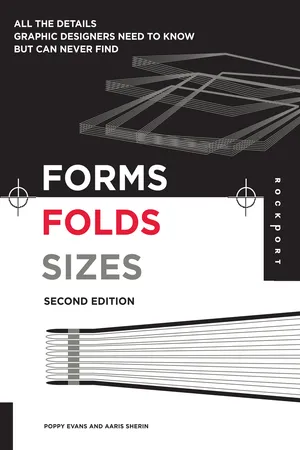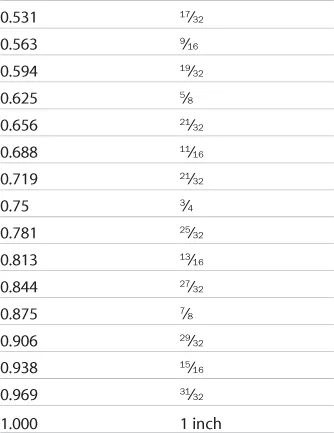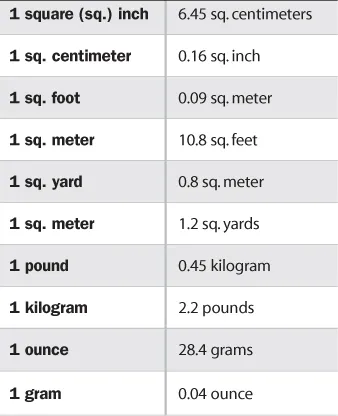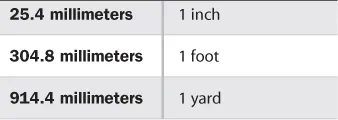![]()
Chapter 1: Measurement Conversion Charts
MILLIMETERS, POINTS, AND PICAS TO INCHES
INCH DECIMALS TO INCH FRACTIONS
CONVERSION FORMULAS
METRIC TO IMPERIAL EQUIVALENTS
![]()
Chapter 2: Copyright and Trademark Standards
COPYRIGHT
Copyright is defined as the exclusive legal right to reproduce, publish, and sell a literary, musical, or artistic work. Anything that is produced is a copyrighted piece of work as soon as it is produced if it falls under one of the above categories. In the United States, a work is under the protection of copyright from the moment it is created until seventy years after its author’s death. During that period, the owner of a copyrighted work owns the rights to its reproduction, display, distribution, and adaptation to derivative works. (Note that a “work” can be copyrighted, but not an idea. Ideas must be patented.) A copyright infringement occurs when somebody copies a copyright protected work owned by someone else or exercises an exclusive right without authorization.
A copyright notice, strategically placed on literary, musical, or artistic work, serves as a warning to potential plagiarizers. A copyright notice consists of the word “Copyright” or its symbol, ©, the year the work was created or first published, and the full name of the copyright owner.
Example: © 2004 John Doe
The copyright notice should be placed where it can be easily seen. Placing a copyright notice on a piece of work isn’t absolutely necessary to claim copyright infringement, but it is in the owner’s best interest to use this symbol as a warning. Original work can be further protected by registering it with the U.S. Copyright Office:
Copyright Office
Library of Congress
101 Independence Ave., S.E.
Washington, DC 20559
(202) 707-3000 (information)
(202) 707-9100 (forms and publications hotline)
www.loc.gov/copyright
Registering an artistic work requires filing an application with the Copyright Office and accompanying it with two visual representations, in printed for digital form, of the work being registered. There is a $45 (£23) nonrefundable fee for paper registration and a $35 (£18) non-refundable fee for electronic filing. Application forms can be found online at www.loc.gov/copyright. The work becomes registered on the date that all the required elements for registration are received by the Copyright Office.
PUBLIC DOMAIN
Older artistic creations, which are no longer protected by copyright, fall into a category called “public domain,” and can be used by anyone without obtaining permission or paying a fee. Uncredited or anonymous works are no longer protected by copyright beyond 95 years after the date of their publication or 120 years after their creation. Works credited to an artist or author are no longer protected beyond 70 years after the creator’s death.
TRANSFERRING RIGHTS
Transferring a copyright means granting permission to another to use or publish the work on a temporary basis. Some common types of transfer rights and what is involved include the following:
First rights: The work is leased for one use where it is published for the first time.
One-time rights: The work is leased for one use, but there is no guarantee that the buyer is the first to have published the work.
Exclusive rights: The leaser retains the right to use or publish the work exclusively in their industry. With an arrangement of this type, an artistic work that appears in a magazine may not appear in another magazine, however it could be used on a greeting card.
Reprint rights: The leaser is given the right to use or publish the work after it has appeared elsewhere. Also called serial rights.
Promotion rights: The leaser is given the right to use the work for promotional purposes. This type of agreement is often tacked onto another rights contract. For instance, an agreement with a greeting card company to use an illustration on a greeting card would include a promotion rights clause giving the company the right to use the same illustration in its promotion of the card.
TRADEMARKS AND SERVICE MARKS
A trademark is a word(s), phrase(s), symbol(s), or design(s) that distinguishes the source of a product from one originator from those of another. A service mark is the same as a trademark except that it distinguishes the source of a service. An infringement occurs when somebody uses or mimics an existing trademark or service mark to represent another product or service so that others are misled into believing they are purchasing the original product or service. It is not necessary to register a logo or mark. A user can establish rights with a mark based on its legitimate use. However, owning a federal trademark registration has advantages:
1. Providing legal presumption of the registrant’s ownership of the mark and exclusive right to use the mark and the ability to bring legal action concerning misuse of the mark.
2. The right to obtain registration in foreign countries and ability to file the U.S. registration with the U.S. Customs Service to prevent importation of infringing foreign goods.
3. Ability to display notice to the public of claim of ownership through the use of the ® symbol.
Users can use the symbols ™ (trademark) and SM (service mark) to alert the public to their claim of rights to a mark, regardless of whether an application has been filed with the United States Patent and Trademark Office (USPTO). However, the federal registration symbol ® can only be used after the USPTO actually registers a mark and not while an application is pending. The registration symbol can only be used with the mark on, or in connection with, the goods and/or services listed in the federal trademark registration.
Registering a trademark or service mark requires filing an application with the United States Patent and Trademark Office. Contact the USPTO at Commissioner for Trademarks, 2900 Crystal Drive, Arlington, VA 22202-3514 (703) 308-9000 (Trademark Assistance Center), www.uspto.gov/teas/index.html.
![]()
Chapter 3: Proofreading and Copywriting
PROOFREADERS’ SYMBOLS
These marks and notations are widely used and understood by editors, proofreaders, and others involved in writing and producing text. Use them when proofing or editing a manuscript or proof.
FOOTNOTES
Notes and footnotes always end with periods, even if they do not form complete sentences. Source lines do not end in periods. Use the following sequence when listing more than one footnote per page:
ABBREVIATION GUIDE
When to abbreviate a word or name and how to abbreviate it will vary, depending on how it is used. Consult the following categories for usage advice on any ...














